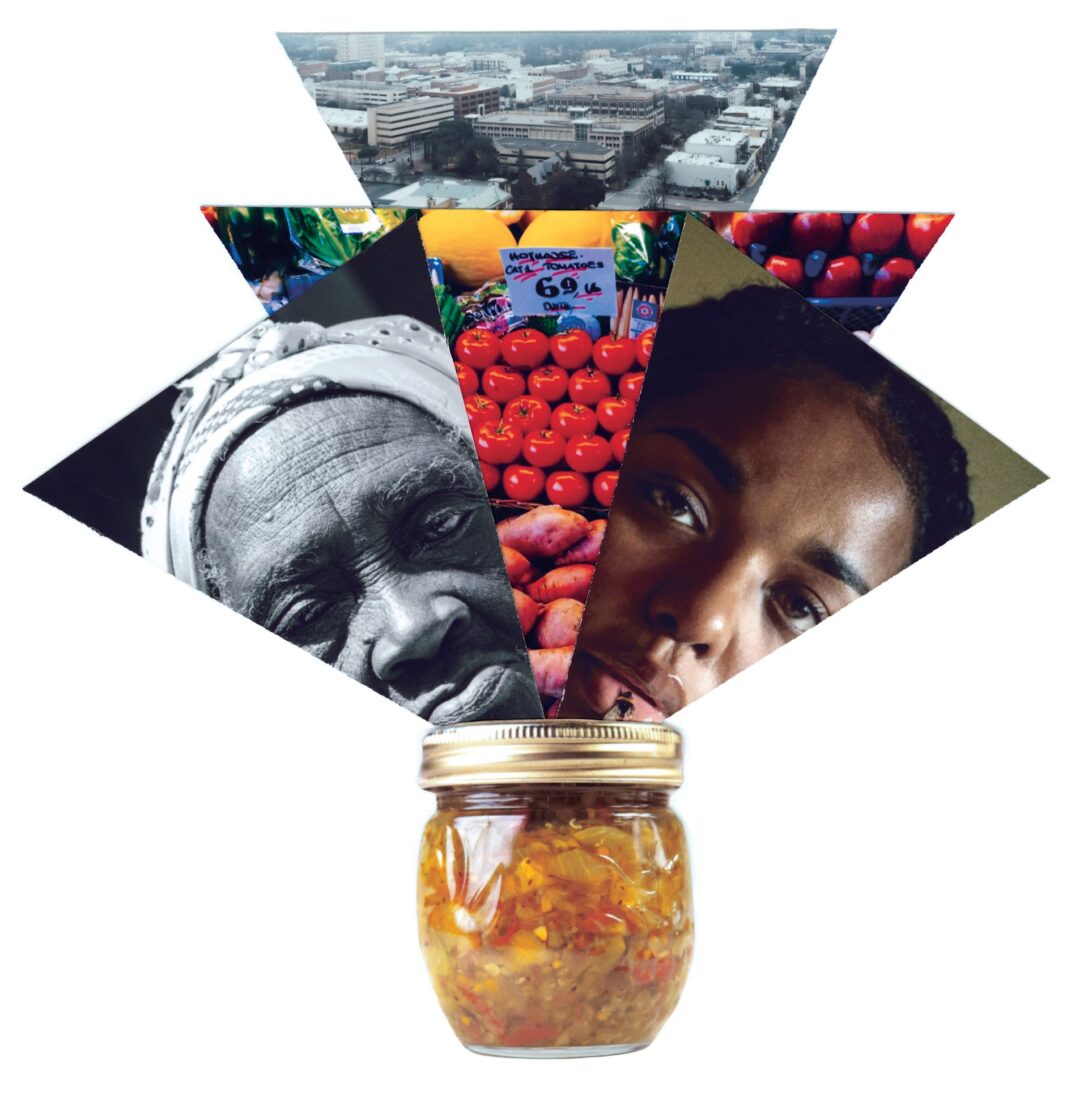When Earth began to tilt away from the sun, and the mountain air cooled enough to flirt with frost, we bundled up and went to the garden. It felt ancestral, that pull, compelling us to tug on our wool things and grab the poplar baskets we kept on the back porch. Everyone in my childhood farming community in the Upstate of South Carolina understood: Frost, that precursor to the deeper Appalachian winter, could destroy what was left in the fields, save perhaps the collards, their leaves left bent and tender. It was under those conditions—darkening and on the verge of freezing—that we, the Graham family, made chowchow.
As with cornbread, in our house you couldn’t have a real meal without the relish, that crunchy, spicy, sweet alchemy of vegetables and copious amounts of vinegar, salt, and sugar that adds a little oomph to greens, field peas, you name it—like edible confetti. No, you couldn’t just use sweet salad cubes (they’re for potato salad) or sweet relish (that’s for deviled eggs) or hot pepper vinegar or a jalapeño jelly. If you didn’t have any homemade on hand, you could go to the grocery for store-bought, but only as a last resort. What’s on the shelf just didn’t have any sweat in it, nor by extension love. Chowchow the way that we made it was hard work. Work that, lately, fewer people seem to feel like doing.
The origins of my favorite condiment are murky; in the absence of hard evidence, theories run rampant. Some credit the Acadians, others the Chinese working on nineteenth-century railroads, others the Germans that have populated the Carolinas since the late 1600s. The foothill borderlands here hold chowchow in such high esteem that Asheville named its annual culinary event series after it.
We have always pickled and canned produce to make the most out of a long growing season. Mama preferred the bread-and-butter pickles she put up in late spring. Her jars were so pretty, filled with nice even slices of cucumber, dainty rounds of onion. So I learned to make chowchow from my daddy’s people; from the time I could stand up long enough to stir a pot, I was Grandma Mary’s assistant, propping myself up on her high stool near the stove to watch the mixture bubble and pop as it slowly deepened from celery to olive green. When I was old enough to do it unattended, the family frequently left the process to me. I didn’t mind, which was a good thing—we sold thousands of jars of chowchow a year at our family’s produce stand, particularly in the wintertime.
The summer before I went off to college, I prepared to leave by canning and carefully packing twenty-four jars of chowchow, along with a dozen jars of homemade salsa, half a case of peach preserves, and a couple of jars of sweet potato butter. No, I was not shipping off for Siberia, but to this Southerner, Dartmouth, in Hanover, New Hampshire, seemed close enough. I worried that I didn’t have enough of my favorite foods to make it through the school year, but Mama convinced me I at least had plenty to make it to winter break. Canning, you see, is also what we do when we’re nervous about the future; the best of our know-how, bottled into sixteen-ounce love notes.
For years after my father died and the produce stand shut down, I would get approached—at church, in the grocery store, even at the library—by people who remembered our chowchow. Often, they would ask me to make them some, pressing their phone numbers into my palm. Sometimes I obliged. But I stopped jarring the relish altogether when Grandma Mary died in 2020. Chowchow had been our thing; we used to chat on the phone about how our batches turned out. I wasn’t prepared for it to just be a me thing.
This level of canning is intense and physical, and when I try to lift the fifty-pound bag of minced vegetables, I feel the fact that I’m not in my twenties anymore
Now I’ve started back. Making chow-chow has become my way of coming to grips with change—of holding on to, and honoring, a past that is slipping away. I recently found out that soon, our old produce stand building will be torn down. Once it is dismantled, all of the things that made me a farmer, including my family’s farm and my father and my grandmother themselves, will be gone.
The other day I drove down Reidville Road, one of the main thoroughfares in my hometown of Spartanburg, and realized that none of the small businesses I remembered from my youth remained. The family-owned cinema has been demolished, replaced by a storage facility. Mr. Chan’s restaurant, with its pagoda-like roof, is gone too. I stared, just for a second, at industrial equipment propped up against a small cement-block building. Before it housed an auto title loan business, before they widened the highway and a Popeyes popped up across the street, this was Graham’s Produce Stand. I could almost see myself staring back out of the large window, and my mother’s homemade signs for COLLARDS or PEACHES, the ones she painted in navy and red in her perfect calligraphy, a hint at her fine-arts background. I spent more than a decade there, often working twelve-hour days, selling people what they needed to make dinner. And while our store’s signs have long since faded, and before long that building will be gone, our recipes live on.
And so I gather the ingredients: cabbage, peppers, green tomatoes, all the onions I can carry, lots of McCormick pickling spice—don’t you dare substitute anything else. Folks may fight over Hellmann’s versus Duke’s, but this is where my family gets down, debating the merit of adding a pinch of turmeric to an established recipe. I toss in an ingredient that might make some purists cringe: Dixie Crystals cane sugar. But that is how Grandma Mary taught me to make it, so that is what I’ll do.
I am cooking to remember, putting my body through the paces. This level of canning is intense and physical, and when I try to lift the fifty-pound bag of minced vegetables draining in the sink, I feel the fact that I’m not in my twenties anymore.
Between all that rinsing and chopping, I look down and realize I have Grandma’s hands. Same color, similar scars, and wrinkles from day-to-day abuse—doing dishes, cooking dinner, running into barbed wire meant to keep the cows contained on the farm. I allow myself, for the first time in almost four years, to miss her, to miss my old life even though I have a good one now. To feel anger at all the things I couldn’t save.
I blame my tears on the twenty-five-pound bag of onions I’m chopping up. The old-school secret to making chowchow was using a hand-cranked sausage grinder—my father would secure it with a C-clamp to a shelf on the porch and we would process hundreds of pounds of vegetables to the necessarily fine consistency. The only change I’ve made to his family’s almost hundred-year-old tradition is that I believe in the mighty powers of a food processor.
Grocery stores, I’ve noticed, don’t carry much chowchow anymore. As the world opened up, other, more international delights—giardiniera, chutneys, chili crisp—offered that buzz of tang, crunch, salt, and sweet that for so long in the South only chowchow could provide. Nothing slaps my tongue like the real thing, though; the usual recipe prescribes plenty of green and hot peppers, but we always add heaps of red pepper flakes anyway. I don’t measure, just swing my hand across the pot and stir clockwise until the color looks right. My nose picks apart all the herbs and spices as the relish cooks: cinnamon, allspice, mustard seed, coriander, bay leaves, ginger, cloves, black pepper, cardamom, mace.
This is the smell of winter. Of home. Of the past. And even though it’s beginning to feel as if this part of me never existed, I know it did. I know because, without even thinking about it, I can still make chow-chow from scratch.








